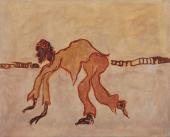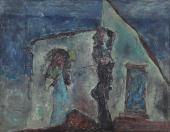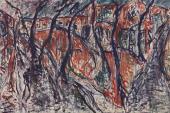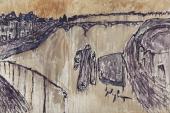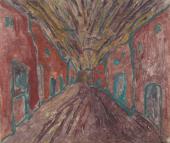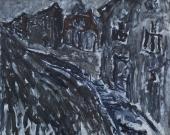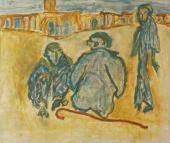Five reasons to visit the exhibition:
1.- The exhibition proposes, with almost sixty works, a representative survey of the artistic production that Luis Claramunt made during the '80s.
2.- The selection shows the artist's predilection for urban spaces in which he finds scenes characteristic of lifes lived without filters and that approache him to an instinctive and immediate world.
3.- Barcelona, Madrid, Seville and Marrakech are for him inexhaustible sources of inspiration over the years.
4.- Despite the extremely relevant show that the MACBA organized in 2012, Claramunt still remains a little known artist for the general public.
5.- This exhibition’s main aims are to reconnect the artist’s work with the public of Barcelona and, by extension, widen the knowledge on the type of painting that was produced in the 1980s
Notes of a siege
"The first time I saw Luis Claramunt, in around 1984 or surely a bit before then, I did not know who he was; he was just a fellow with a strikingly unique appearance, shirtless, dressed in black, with the look of a flamenco guitar player or singer, seated at the table with our mutual friend Fernando Huici, in such a typical place as the Cervecería Alemana in Madrid’s Plaza de Santa Ana. I thought to myself: “Is Huici organising flamenco events now?” I immediately realised that no, this fellow was a painter, and one of some consequence, and that on top of that he was not even a gypsy but born in Barcelona’s Ensanche district, the son of a decorator and a pianist – I actually learned about his parents much later, by the time the painter was already deceased – and educated at the French School. A fan of living dangerously, he had taken to that world so much that he actually blended in with it."
Juan Manuel Bonet
Biography
Luis Claramunt (Barcelona, 1951 - Zarautz, 2000)
Luis Claramunt, was born in Barcelona on the 19th of August 1951. His mother was a Piano player and his father a well-recognised interior decorator. In the late 1960s Luis started studying Philosophy and Humanities at the university, but two years later he left his studies to work as a professional painter. Claramunt entered the world of art on his own, as a self-taught artist with no allegiance to any particular school. This shift in profession simultaneously led him to take the decision to move near Plaça Reial and leave his family home, thus starting the process of detaching himself from his wealthy roots.
From then on, he lived a totally bohemian lifestyle which led him to forge and build strong ties with the gypsy families from that era, allowing him to become familiar with the culture and customs of this ethnic group. This context, in which he lived for years, aroused in Claramunt a liking for the “hard side of cities”, as he called it, including cockfights, bullfighting, ports, Chinatowns, after-hours bars and street markets…
All of these marginal, dangerous places in the city fascinated Claramunt. From this period are his urban landscapes with a somewhat dramatic feel and his paintings of deformed and grotesque human figures, which are depicted using a vibrant and dynamic brushwork, dominated by a narrow colour palette of ochre and bluish tones. All in all, a clearly expressionist type of painting that reveals the influences stemming from his admiration of the works of Van Gogh, Picasso, Nonell, Soutine, Munch and Schiele.
He moved to Madrid in the mid-1980s, where he would live permanently after periodically spending long sojourns in different cities like Bilbao, Seville and Marrakesh. He often travelled to the Moroccan city from Seville, and important works emerged from these journeys, which show a finely tuned language in which human figures come to the fore in his canvases.
In the late 1980s his works became more mature, free of expressive elements and evolving to a more synthetic form of painting. Blots gave way to lines, and colour and texture became predominant. In the 1990s he moved permanently to Madrid, where his work became more abstract.
Luis Claramunt died in Zarautz at the age of 49 during the morning of the 18th of December 2000.
Claramunt and the '80s
Luis Claramunt
Claramunt and Léonard




